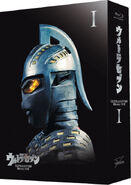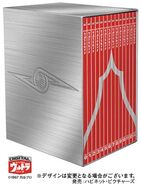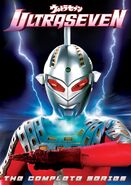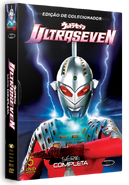Ultraseven is the third entry of the Ultraman Series, created by Tsuburaya Productions. Contrasting Ultraman before it with its various monsters, Ultraseven expands much more on the concepts of alien invasions and militarism. Ultraseven was originally conceived to be a separate entry to Ultraman until Return of Ultraman later retconned the two continuities into one.
The series can be watched on Shout TV, Pluto TV, Tubi, and Prime Video.
Production
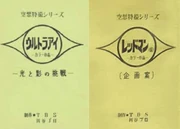
The early scripts of Ultra Eye and the project proposal for Redman.[1]
In October 1966, TBS approached Tsuburaya Productions with a request to produce a series that would expand the setting into space, including the direction for the fourth quarter of Ultraman. Tsuburaya's literary department, led by playwright Tetsuo Kinjo, had already planned to extend the story's background into space during the preparation stages of the new program. They aimed to transition from the "monster boom" to a "space boom," initiating discussions on this project since autumn 1966. The initial concept unified the enemies as extraterrestrial invaders. The first proposal was Space Base No.7 , followed by the Ultra Guard project proposed around October 1966, which did not involve the appearance of a giant hero but rather depicted a sci-fi battle between the Ultra Guard and extraterrestrial invaders.[2][3]
Considering the high ratings and production progress of Ultraman, Tsuburaya Productions prioritized its filming, causing delays in the production schedule for Ultra Guard. By early 1967, due to scheduling issues, TBS decided to conclude the production of "Ultraman." Concurrently, TBS presented Tsuburaya Productions with plans for a new series. As part of the schedule change, Toei Tokyo Productions' Captain Ultra was set to air in two quarters starting from the third week of April 1967, while Tsuburaya Productions worked on their new series during this period, planning for an October premiere. TBS continued to emphasize the "space theme," aiming to appeal to a broader age group than Ultraman.[2]
In spring 1967, under the leadership of Tetsuo Kinjo, the literary department of Tsuburaya Productions ultimately planned Ultra Eye , a revised version of the Ultra Guard project. In his proposal at the time, Kinjo wrote:
"In previous series, we were at the forefront of the monster craze, but we cannot be satisfied with the status quo. I want to take even a step forward into the next phase. Space."
- ―Tetsuo Kinjo[4]
This series tells the story of Dan Moroboshi, a hybrid boy of Earth and the planet R, who secretly operates as Redman while serving as the driver of the TDF's Ultra Guard supercar. Redman's character embodies the description of a "Ultraman Junior." In this project, Dan is a super-powered individual who comes to Earth in search of his mother. It also portrays his subtle romantic feelings towards an Earth girl, aiming to attract older audiences through a romantic storyline of youthful heroism. In this setting, Dan carries capsules containing miniaturized monsters that appeared in Ultra Q and Ultraman.[2][3]
Subsequently, Ultra Eye was reimagined and developed into the provisional title Redman . This project centered around the theme of "alien invasion," featuring a variety of extraterrestrial beings in each episode. During this phase, detailed descriptions were provided for the TDF and UG, and the character Dan transitioned from a youthful image to that of a young adult. He was designated as Committee No.3117 of the Space Orbital Map from the Nebula M78, transforming using special glasses.[2][5]
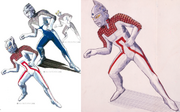
Tohl Narita's early character concept designs for Ultraseven.[6][7]
Upon completion of the fourth episode and subsequent trademark registration, the series was officially titled Ultraseven[1]. The origin of this title dates back to Tetsuo Kinjo's original plan for a successor to Kaiju Booska, borrowing the title from an unproduced comedic work involving "seven ape-men in the primitive era."[8] The title was chosen for its catchy and phonetically advantageous qualities, solidifying its status as the official title. Tohl Narita continued to oversee the series' design, expanding the aesthetic from a mechanical feel to a more armored appearance during the design process, ultimately settling on the finalized version seen today.[5]
During the planning stages, this production was heavily influenced by the British series Thunderbirds. In terms of commercial promotion, it introduced more mechanical merchandise than Ultra Q and Ultraman. Reflecting on the production delays experienced with Ultraman, unavoidable time-consuming issues in art and special effects production were taken into consideration during this period. Tsuburaya Productions began rigorously controlling budgets and reinforcing production systems. This included rationalizing filming locations, documenting special effects scenes, and experimenting with creating props from everyday items. Simultaneously, significant effort was invested in scriptwriting, such as developing storylines devoid of monsters and featuring non-humanoid alien types.

By depicting battles and conflicts, as well as thought-provoking and deep storylines, this series showcases the multifaceted thinking conveyed to the audience.[9]
In its narrative approach, Ultraseven elevated beyond conventional children's entertainment by integrating profound critical and philosophical themes. This departure from its predecessor, Ultraman, which typically delineated clear distinctions between good and evil, showcased mature character portrayals. Ultraseven depicted a warrior dedicated to defending Earth's people while also exploring the poignant struggles faced by aliens navigating the complexities between Earth and the vast expanses of the universe. This innovative approach provided a serious perspective seldom explored in earlier hero series.[10]
According to the project description, Ultraseven establishes a fundamental worldview where Earth becomes embroiled in intense interstellar conflicts, with various aliens beings adopting a coercive "invasion" policy towards Earth in a semi-competitive manner. This premise, established by Tetsuo Kinjo, imbues the series with a significant degree of science fiction thinking. In contrast to the previous series Ultraman, which focused on eliminating entities disrupting "order," Ultraseven's mission is to defend Earth amidst this chaos. The narrative significance of the series lies in how to resist and respond to unequivocal attacks without room for negotiation, and the struggles of those involved in this process.[11]
Simultaneously, the series balanced its entertainment value for child audiences through varied styles of battle scenes ranging from hardcore to humorous, alongside impressive performances by the UG members. This ensured Ultraseven maintained its status as a top-tier show in the family-oriented tokusatsu hero genre.[5][12]
Originally planned for 39 episodes like Ultraman, this series decided in December 1967 to extend by 10 episodes. Concurrently, Captain Ultra experienced a decline in ratings from mid-season, dropping to 20%-25% (averaging 25.6%). However, Ultraseven premiered and quickly rebounded to a high viewership of 30%, earning positive evaluations from both television stations and sponsors.
After the third season, due to budget constraints, the storyline featured only humanoid-like invaders. This development caused a disconnect with child audiences. However, the production team did not attempt to change to cater to the audience but persisted with the same production style, continuing to emphasize themes of justice, courage, and hope. During this period, average ratings fluctuated between 17% and 23%. Additionally, Japanese media began emphasizing supernatural and sports-themed inspirational genres, reflecting a trend towards the belief that monster series had become outdated. Planning meetings for Tsuburaya Productions' follow-up series Operation: Mystery officially commenced on January 12, 1968.[13]
On September 28, 1968, after the final episode of 'Ultraseven aired, its viewership rate surged back to nearly 28.5%[14], close to its premiere rate. Despite this, the series marked a hiatus for the "Special-Effects Fantasy Series". Nevertheless, consistently steering the storyline towards an expansive narrative without major changes, it gradually earned high acclaim in the years that followed. Subsequently, it has been rerun numerous times on Japanese television.

Promotional poster for Ultraseven 55th Anniversary.
To this day, the series maintains tremendous popularity within the entire Ultraman series, with actors and production staff alike considering it the pinnacle of the series.[15][16] Even fifty years after its original broadcast ended, satellite and terrestrial channels continue to frequently air it. In 2020, NHK even broadcast a digitally remastered 4K high-definition version[17]. Additionally, the series has spawned two sequel series that continue its storyline, and a large-scale commemorative event was held in 2023 to celebrate its 55th anniversary.[18]
Synopsis
In the not-too-distant future, the Earth finds itself constantly under attack from extraterrestrial threats. To combat them, the Terrestrial Defense Force establishes the Ultra Guard, a team of six elite members who utilize high-tech vehicles and weaponry. Joining their fight is the mysterious Dan Moroboshi who is secretly an alien from the Land of Light in Nebula M78, Ultraseven.
Characters
Protagonist
TDF
UG
Ultras
Kaiju
- Capsule Kaiju
- Alien Cool
- Alien Waiell
- Alien Pitt
- Eleking
- Alien Godola
- Alien Villa
- Alien Pegassa
- Alien Quraso
- Alien Metron
- Alien Chibull
- Zero One
- Alien Icarus
- Alien Wild
- Nurse
- Alien Spell
- Alien Iyros
- Amagi and Furuhashi duplicates
- King Joe
- Alien Pedan
- Annon
- U-Tom
- Alien Bell
- Gumonga
- Space Suflan
- Blood-Sucking Acari
- Alien Bado
- Alien Shaplay
- Giradorus
- Iron Rocks
- Alien Mimy (Voice only)
- Alien Braco
- Gabura
- Alien Shadow
- Alien Cannan
- Gandar
- Alien Poll
- Star Bem Gyeron
- Alien Borg
- Dinosaur Tank
- Alien Kill
- Alien Prote
- Alien Platic
- Dallie
- Rigger
- Shadowman
- Alien Uley
- Dancan
- Petero
- Alien Zamppa
- Alien Pega
- Alien Magellan "Maya"
- Alien Banda (Mentioned, but only their ship appears)
- Crazygon
- Alien Guts
- Aron
- Tepeto
- Alien Tepeto
- Guyros
- Nonmalt
- Robot Chief
- People of the Fourth Planet
- Alien Goron
- Gorry
- Alien Perolynga
- Imit-Ultraseven
- Alien Salome
- Alien Hook
- Alien Ghose
- Pandon
- Reconstructed Pandon
Cast
- Dan Moroboshi : Kohji Moritsugu
- Anne Yuri : Yuriko Hishimi
- Kaoru Kiriyama : Shoji Nakayama
- Shigeru Furuhashi : Sandayu Dokumamushi
- Soga : Shinsuke Achiha
- Amagi : Bin Furuya
- Yamonaka : Susumu Fujita
- Takenaka : Kenji Sahara
- Manabe : Yoichi Miyagawa
- Ueno : Yoshio Katsube
- Narrator : Hikaru Urano
English Dub
- Vlasta Vrana as Narrator
- Roby Roy as Dan Moroboshe
- Dean Hagopian as Furuhashi
- Marc Denis as Soga
- Tim Webber as Takenaka
- Jane Woods as Donna
- Jean Fontaine as Kiriyama
- Arthur Grosser as Manabe
Suit Actors
- Ultraseven : Koji Uenishi
Music
- Opening Theme
- Ultraseven no Uta
- Lyrics: Kyōichi Azuma
- Composition & Arrangement: Toru Fuyuki
- Artist: The Echoes & Misuzu Children's Choral Group
TNT Episodes
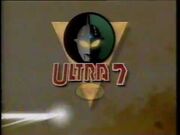
In 1985, Turner Program Services commissioned Cinar to dub all 49 episodes for run in syndication.[19]The Cinar-produced episodes featured new opening and closing credits, new eyecatches, and even new episode names. After failing to sell the series to national and local stations, Turner put the tapes back into their vaults until 1994, when Ultraseven was selected for broadcast on the Toons 'Till Noon and MonsterVision blocks on TNT. The Toons 'Till Noon broadcasts received substantially heavy editing to make them suitable for the time slot, while the MonsterVision broadcasts were left completely uncut. Episodes 5-7 were missing but, instead of paying Cinar for the missing episodes, they aired all the tapes they had already. When the contract expired between Tsuburaya, Cinar, and Turner, all materials (film, tapes, audio masters, etc.) reverted back to, and were collected by, Tsuburaya.
Cinar Titles
- Enter Dan Moroboshi
- Shrubs from Space
- Currently unknown
- Double Trouble at Sea
- Currently unknown
- Currently unknown
- Currently unknown
- Smokers on the Rampage
- Toys in Crisis
- The Man Next Door
- Captured in Living Color
- Crystallized Corpuscles
- Space Ace Reunion
- Planets in Conflict (Part 1)
- Planets in Conflict (Part 2)
- The Eyes Have Had It
- Cave-In
- The Bells Are Ringing
- Wayne, Lord of the Universe
- The Quakemaker
- The Nissans Return Engagement
- The Chromosome Eaters
- The Fugitive Fortune Teller
- Mother Knows Best
- Ultra-7 Exposed
- The 8,000 Megaton Mistake
- Temporary Traitor
- Death on Wheels
- The Apprentice Alien
- Trial by War
- Blood-Thirst
- Island in the Sky
- The Dead Invaders
- Urban Removal
- Moon-Stuck
- Sharpshooter Showdown
- The Devil's Angel
- The Brave One
- Ultra-7 Tastes Defeat
- Ultra-7 Execution at Dawn
- Killer Lake
- The Boy on the Beach
- Tyranny by Design
- The Stargazer
- Simian Says Surrender
- Dan and the Ultra-7 Challenge
- Home, Sweet... Homes???
- Exit Ultra-7 Part 1
- Exit Ultra-7 Part 2
Direct Sequels and Related Media
Movie
A movie adaptation of episode 18 was published July 21, 1968, in the Toei Manga parade.
Heisei Ultraseven
- Main article: Heisei Ultraseven
Twenty-seven years after the end of the original Ultraseven series, Tsuburaya made two TV specials that continued after the original story left off, having Seven come back to Earth, then two years later, a slue of direct-to-video sequels. Each of the new episodes took place in a continuity where Ultraseven was the only Ultra Warrior that ever came to Earth.
Ultraseven X
- Main article: Ultraseven X
Ultraseven travels to another world to fight off invaders who plan to cross over using a portal and silently take over the world. Ultraseven bonds with a man named Jin, an amnesiac who has a past linked to the events that are secretly conspiring.
Ultraseven IF Story “The Future 55 Years Ago”
- Main article: Ultraseven IF Story “The Future 55 Years Ago”
This work is a short film specially produced to celebrate the 55th anniversary of the original Ultraseven series. It is based on a scenario from the 1967 television series that "may have existed," presenting an "IF Story" and depicting the development of events.
Home Media
In 2012, Shout! Factory obtained a license to subtitle Ultraseven in English, and released it for sale on their website as a physical boxed CD set, which is only available for shipping within the U.S. and Canada. Episode 12, however, was not included, so the total number of episodes in this release was 48. On December 11, 2012, Shout! Factory made the set available through regular retailers. This time, the case was a standard DVD keep case.
Ultraseven Blu-ray Box I features episodes 1-25 (except for episode 12), and Blu-ray Box II features episodes 26-49.
Mill Creek is also set to release the complete Ultraseven series on December 10, 2019, as both SteelBook and standard Blu-ray releases.
On July 7, 2023, to commemorate the 55th anniversary of the series, a 4K/HDR remastered edition titled "ULTRAMAN ARCHIVES Ultraseven 4K UHD & MovieNEX" was released. This remastered edition utilized the original 16mm negatives for digital restoration and enhanced the original footage's brightness, color, and depth using the MGVC format.[20][21]
Gallery
Trivia
- Ultraseven has two banned episodes: "From Another Planet with Love" (banned because Alien Spell resembled survivors of the atomic bombings of Japan in World War II), and "Super Weapon R-1" (banned in 2011 because of the episode relating to the recent Fukushima Daiichi nuclear disaster).
- Due in part to its ban, the episode 12 is not on the Region 1 DVD release by Shout! Factory. However, the recently banned 26th episode was released and can be seen on this set.
- Ultraseven was originally intended to be the last entry into the Ultraman Series. Its immense popularity proved otherwise.
- Sequels for both Ultraman, titled Ultraman Continues, and Ultraseven, titled Fight! Ultraseven, were proposed, but Tsuburaya Productions would not produce another Ultraman Series TV show until 1971 with Return of Ultraman.
- A few soundtracks from this TV series would be used again later in Ultraman Ace, Ultraman Leo, and Ultraman 80.
- Clips of Ultraseven were shown on an episode of Space Ghost Coast to Coast, with the host trying to get guest Joel Hodgson to help "MST" them.
- The Ultraseven on the cover sleeve of Shout! Factory's DVD box set Ultraseven: The Complete Series is the Ultraseven suit made by Chaiyo.
- The titular hero of the TV series is sometimes incorrectly named "Ultraman Seven" by many sources outside Japan (or, in the case of KHON/Honolulu, Hawaii, Ultra-7, as listed in TV Guide when it ran in 1975). Both the TV series and its hero can also be named Ultra Seven (with a space).
References
- ↑ 1.0 1.1 https://qqquuu7.web.fc2.com/7eye.html
- ↑ 2.0 2.1 2.2 2.3 Ultra Tokusatsu PERFECT MOOK vol. 1: Ultraseven, pg 4
- ↑ 3.0 3.1 https://cocreco.kodansha.co.jp/telemaga/news/ycfeN
- ↑ https://business.nikkei.com/atcl/report/15/070300016/070100026/
- ↑ 5.0 5.1 5.2 https://cocreco.kodansha.co.jp/telemaga/news/ycfeN?page=2
- ↑ https://www.fukkan.com/fk/CartSearchDetail?i_no=68326252
- ↑ https://www.aomori-museum.jp/collection/narita/
- ↑ https://blog.goo.ne.jp/mk1_1978/e/4519f1821ce05a43e672837f5f1934e6#m26
- ↑ https://hochi.news/articles/20230721-OHT1T51045.html?page=1
- ↑ https://cocreco.kodansha.co.jp/telemaga/news/Uq3NG
- ↑ https://cocreco.kodansha.co.jp/telemaga/news/rTwFD
- ↑ https://cocreco.kodansha.co.jp/telemaga/news/UrWhA
- ↑ https://www.sankei.com/article/20170727-SQKX2KBLOZN3DKD67J23ZYCWKE/2/
- ↑ https://www.sankei.com/article/20170727-SQKX2KBLOZN3DKD67J23ZYCWKE/3/
- ↑ https://news.mynavi.jp/article/20170817-ultraseven/
- ↑ https://www.sanspo.com/article/20230222-J3LMIAOWMFJ43C2KCBWN7NLYGQ/
- ↑ https://m-78.jp/news/post-5593
- ↑ https://m-78.jp/news/post-6464
- ↑ http://grnrngr.com/documents/miyake/ultra7.txt
- ↑ https://m-78.jp/news/post-6700
- ↑ https://www.kinejun.com/article/view/26717

